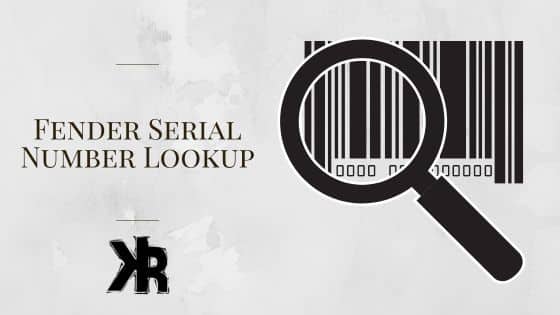Table of Contents
Fender serial numbers span many decades, with different code arrangements. Some, are more complex than others, but they all provide some important information to the owner. It’s a practical tool for those who seek to understand the lineage of their instrument.
Fender, a name that resonates with the rhythm of rock and roll, blues, and jazz, has a complex system of serial numbers.
These numbers, etched into the guitars, are more than mere identifiers. They are a coded chronicle of the instrument’s birth, a testament to its authenticity, and a window into its past.
This Killer Rig article will serve as a compass, guiding you through the maze of Fender’s serial numbers. We’ll dissect the code, understand its evolution, and learn how to decode it.
We’ll also provide a comprehensive chart for quick reference, aiding you to authenticate your Fender guitar or trace its history.
We have more great decoder tools:
Understanding Fender Serial Numbers
Fender serial numbers, like most other, are a code system that keeps track of the instrument from the day of production to present.
They are not randomly placed, but are a structured system, and one that has evolved over time. Understanding this system can offer insights into the origin, age, and model of a Fender guitar.
Where to Find the Serial Number?
Depending on the model and year of manufacturing, the serial number’s placement varies. The headstock, the neck plate, or the bridge plate are typical places.
How Does the Fender Serial Number System Work?
Fender’s serial number system has changed over the years. The system includes a combination of numbers and letters, with the format and location varying based on the era of production.
For example, a Fender guitar with a serial number starting with “L” on the neck plate was likely produced between 1963 and 1965. If the serial number is L20000, it was likely made in 1964.
Decoding Fender Serial Numbers
Figuring out a Fender guitar’s serial number might seem pretty tough! Especially on older models. Many different methods have been used over time, but their system is better than other manufacturers.
There should be enough to give you some information about your guitar and the road it has traveled.
A Word of Caution
While decoding Fender serial numbers can provide valuable information about the guitar, it’s important to remember that it’s not an exact science. There are exceptions and anomalies in Fender’s serial number system.
Therefore, it’s always a good idea to verify the information with other characteristics of the guitar, such as the body shape, pickups, and hardware.
In the next section, we will provide a detailed Fender Serial Number Lookup Guide. It will assist you in decoding your Fender guitar’s serial number.
Fender Serial Number Lookup Guide
This guide provides a detailed breakdown of Fender serial numbers based on the information gathered from various sources. Use this chart to help decode the serial number on your Fender guitar.
Keep in mind that these are only Fender serial numbers. If you are looking for Squier serial numbers, click here.
Early Years (1950-1954)
This era of guitars has three to four digits in the serial number and is located on the bridge plate. You will see it stamped there near the saddles.
| 0001 to 0999 | 1950 – 1952 | Broadcaster, Telecaster, Esquire Guitars |
| 000 to 5300 | 1952 – 1954 | Broadcaster, Telecaster, Esquire Guitars |
| 161 to 1900 | 1951 – 1954 | Precision Basses |
Some Telecasters will have a date recorded inside the neck joint. This will mainly be guitars from 1952. In order to get at it, the neck will have to be taken off the body.
Neck Plate (1954-1963)
In 1954, Fender began the practice of inscribing serial numbers on a metallic plate positioned at the back of their guitars. This is also known as the neck plate.
This act of serial number stamping is of significant use when you’re trying to pin down the creation date of Stratocasters from 1958 onwards, Telecasters, Jazzmasters, and Jaguars post-1962.
A key piece of trivia to keep in mind: a few of the very first Stratocasters bear a four-digit serial number. Rather intriguingly, this number is etched onto the white plastic cover of the tremolo plate. A cover found at the rear side of the guitar’s body.
| 0001 to 7000 | 1954 |
| 7001 to 9000 | 1955 |
| 9001 to 17000 | 1956 |
| 17001 to 25000 | 1957 |
| 25001 to 34000 | 1958 |
| 34001 to 44000 | 1959 |
| 44001 to 59000 | 1960 |
| 59001 to 71000 | 1961 |
| 71001 to 93000 | 1962 |
| 93001 to 99999 | 1963 |
L Series (1963-1965)
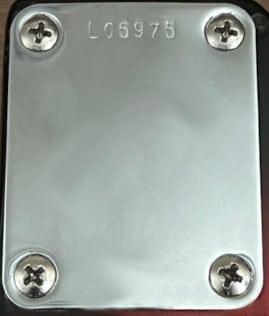
The Fender serial numbers that begin with an L can be found in this table. Fender began to change their serial code structure as production really started to ramp up.
However, the year of manufacture can also range quite a bit as a result. These will also be found on the neck plate on the rear of the guitar.
| L00001 to L20000 | 1963 |
| L20001 to L59000 | 1964 |
| L59001 to L99999 | 1965 |
F Series (1965-1976)
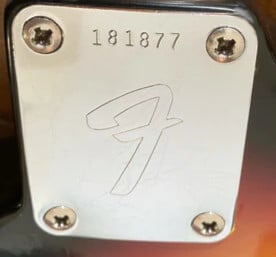
The F series serial numbers came into effect with the new owners of Fender called CBS. They continued to use the neck plate as the location of the code. But now they also added a stylized “F” under the serial number.
| 100000 to 110000 | 1965 (Late) |
| 110001 to 200000 | 1966 |
| 200001 to 210000 | 1967 |
| 210001 to 250000 | 1968 |
| 250001 to 280000 | 1969 |
| 280001 to 300000 | 1970 |
| 300001 to 340000 | 1971 |
| 340001 to 370000 | 1972 |
| 370001 to 520000 | 1973 |
| 500001 to 580000 | 1974 |
| 580001 to 690000 | 1975 |
| 690001 to 750000 | 1976 |
Headstock Serial Numbers (Post 1976)
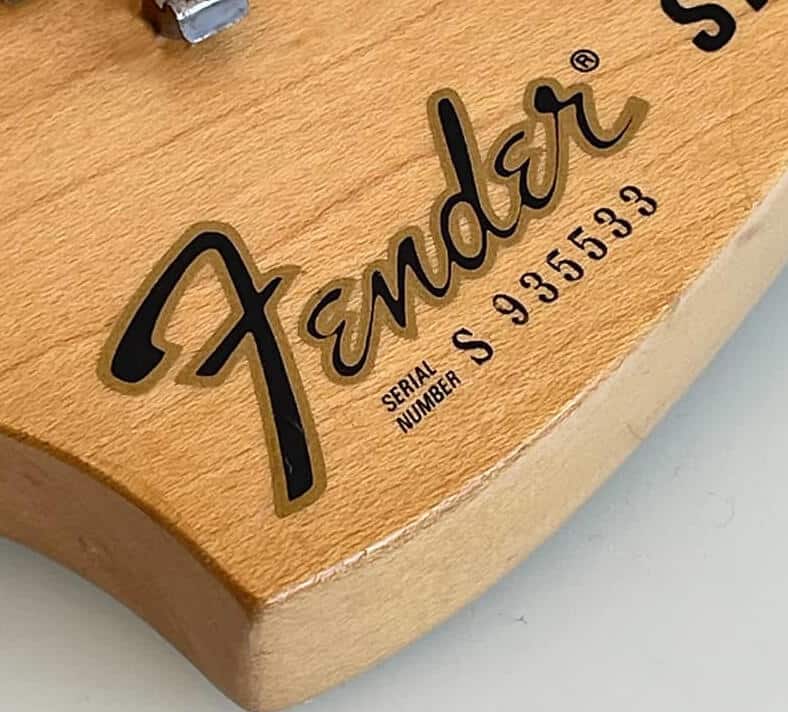
In 1976, Fender began to add the serial number to either the front or rear of the headstock. This depends on the decade in which they were made. They also began adding a letter to the front of the serial code.
This letter represents the decade in which the instrument was made. For example:
- S = 1970s.
- E = 1980s.
- N = 1990s.
- DZ or Z = 2000s.
- US = 2010 to present.
1976 – 1989
The serial numbers for this decade are not as accurate as one would hope. The amount of overlap was quite broad, and so it’s best to try and date these guitars by potentiometer codes if at all possible.
| S8 + 5 digits | 1978 |
| S9 + 5 digits | 1978 – 1979 |
| E0 + 5 digits | 1979 – 1981 |
| E1 + 5 digits | 1980 – 1982 |
| E2 + 5 digits | 1982 – 1983 |
| E3 + 5 digits | 1982 – 1985 |
| E4 + 5 digits | 1984 – 1988 |
| E8 + 5 digits | 1988 – 1989 |
| E9 + 5 digits | 1989 (End) |
1990 – 1999
For this decade, the serial numbers begin with the letter “N”.
| N9 + 5 digits | 1990 |
| N0 + 5 digits | 1990 – 1991 |
| N1 + 5 or 6 digits | 1991 – 1992 |
| N2 + 5 or 6 digits | 1992 – 1993 |
| N3 + 5 or 6 digits | 1993 – 1994 |
| N4 + 5 or 6 digits | 1994 – 1995 |
| N5 + 5 or 6 digits | 1995 – 1996 |
| N6 + 5 or 6 digits | 1996 – 1997 |
| N7 + 5 or 6 digits | 1997 – 1998 |
| N8 + 5 or 6 digits | 1998 – 1999 |
| N9 + 5 or 6 digits | 1999 |
2000 – 2009
The letter “Z” was used to begin the serial numbers for this era. But “DZ” can also be found on guitars made in this period.
| Z0 + 5 or 6 digits | 2000 – 2001 |
| Z2 + 5 or 6 digits | 2001 – 2002 |
| Z3 + 5 or 6 digits | 2003 – 2004 |
| Z4 + 5 or 6 digits | 2004 – 2005 |
| Z5 + 5 or 6 digits | 2005 – 2006 |
| Z6 + 5 or 6 digits | 2006 – 2007 |
| Z7 + 5 or 6 digits | 2007 – 2008 |
| Z8 + 5 or 6 digits | 2008 – 2009 |
| Z9 + 5 or 6 digits | 2009 |
2010 – Present
After 2010, Fender began using “US” in front of their serial numbers for all USA made instruments. They continue to do so even now at the time of this writing.
| US10 + 6 digits | 2010 |
| US11 + 6 digits | 2011 |
| US12 + 6 digits | 2012 |
| US13 + 6 digits | 2013 |
| US14 + 6 digits | 2014 |
| US15 + 6 digits | 2015 |
| US16 + 6 digits | 2016 |
| US17 + 6 digits | 2017 |
| US18 + 6 digits | 2018 |
| US19 + 6 digits | 2019 |
| US20 + 6 digits | 2020 |
| US21 + 6 digits | 2021 |
| US22 + 6 digits | 2022 |
| US23 + 6 digits | 2023 |
Japanese Serial Numbers (1982-2008)
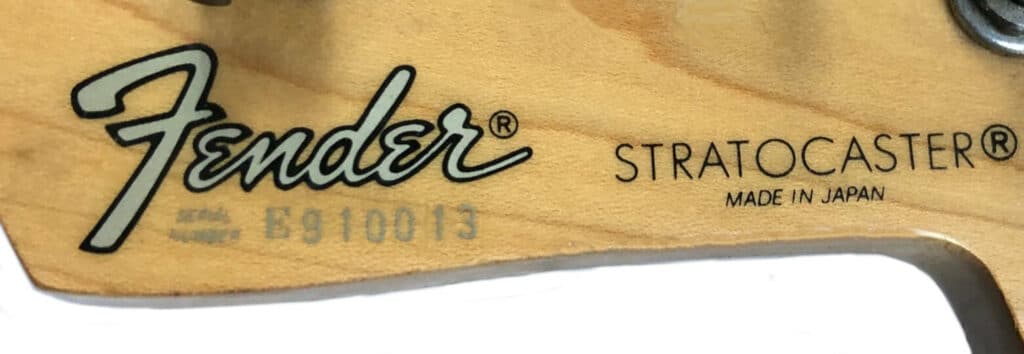
Fender guitars that were built in Japan were marked in two different ways for certain years. They were “made” and “crafted” in Japan. The serial numbers could normally be found on the back of the neck.
Made In Japan
| JV + 5 digits | 1982 – 1984 |
| SQ + 5 digits | 1983 – 1984 |
| E + 6 digits | 1984 – 1987 |
| A + 6 digits | 1985 – 1986 |
| B + 6 digits | 1985 – 1986 |
| C + 6 digits | 1985 – 1986 |
| F + 6 digits | 1986 – 1987 |
| G + 6 digits | 1987 – 1988 |
| H + 6 digits | 1988 – 1989 |
| I + 6 digits | 1989 – 1990 |
| J + 6 digits | 1989 – 1990 |
| K + 6 digits | 1990 – 1991 |
| L + 6 digits | 1991 – 1992 |
| M + 6 digits | 1992 – 1993 |
| N + 6 digits | 1993 – 1994 |
| O + 6 digits | 1993 – 1994 |
| P + 6 digits | 1993 – 1994 |
| Q + 6 digits | 1993 – 1994 |
| S + 6 digits | 1994 – 1995 |
| T + 6 digits | 1994 – 1995 |
| U + 6 digits | 1995 – 1996 |
| V + 6 digits | 1996 |
Crafted In Japan
The label crafted in Japan only last a short period. It was then changed back to Made in Japan after 2008.
| A + 6 digits | 1997 – 1998 |
| O + 6 digits | 1997 – 2000 |
| P + 6 digits | 1999 – 2002 |
| Q + 6 digits | 2002 – 2004 |
| R + 6 digits | 2004 – 2005 |
| S + 6 digits | 2006 – 2008 |
| T + 6 digits | 2007 – 2008 |
Made in Mexico Serial Numbers (From 1990)

The Made in Mexico Fender guitars carry a serial number on the headstock that begins with the letter “M”. After it is another letter which has changed through the decades, much like the US made guitars.
For the nineties and early 2000s, the letters were different. Now, they use “MX” and probably will do so moving forward. The table below will help you find your build and date.
| MN0 + 5 or 6 digits | 1990 |
| MN1 + 5 or 6 digits | 1991 |
| MN2 + 5 or 6 digits | 1992 |
| MN3 + 5 or 6 digits | 1993 |
| MN4 + 5 or 6 digits | 1994 |
| MN5 + 5 or 6 digits | 1995 |
| MN6 + 5 or 6 digits | 1996 |
| MN7 + 5 or 6 digits | 1997 |
| MN8 + 5 or 6 digits | 1998 |
| MN9 + 5 or 6 digits | 1999 |
| MZ0 + 5 or 6 digits | 2000 |
| MZ1 + 5 or 6 digits | 2001 |
| MZ2 + 5 or 6 digits | 2002 |
| MZ3 + 5 or 6 digits | 2003 |
| MZ4 + 5 or 6 digits | 2004 |
| MZ5 + 5 or 6 digits | 2005 |
| MZ6 + 5 or 6 digits | 2006 |
| MZ7 + 5 or 6 digits | 2007 |
| MZ8 + 5 or 6 digits | 2008 |
| MZ9 + 5 or 6 digits | 2009 |
| MX10 + 6 digits | 2010 |
| MX11 + 6 digits | 2011 |
| MX12 + 6 digits | 2012 |
| MX13 + 6 digits | 2013 |
| MX14 + 6 digits | 2014 |
| MX15 + 6 digits | 2015 |
| MX16 + 6 digits | 2016 |
| MX17 + 6 digits | 2017 |
| MX18 + 6 digits | 2018 |
| MX19 + 6 digits | 2019 |
| MX20 + 6 digits | 2020 |
| MX21 + 6 digits | 2021 |
| MX22 + 6 digits | 2022 |
| MX23 + 6 digits | 2023 |
Vintage Series
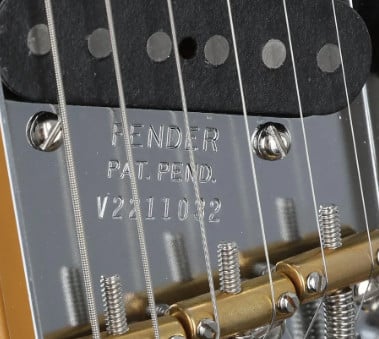
In 1982, Fender released the Vintage Series guitars that were made in the USA. These guitars have a serial number that begins with the letter “V” and has 4, 5, or 6 digits following it.
Older models can only be dated by removing the neck from the body and checking the heel. The date is normally stamped there, confirming the year it was built.
Newer versions like the American Vintage II don’t have this issue. The serial numbers contain the date and are easy to see stamped into the bridge plate. Current models use the “V” plus 7 digits. The first two contain the year of manufacture.
Other Serial Numbers
There are many odd ball serial numbers that were used throughout the decades. Not all of them make sense, nor were they suppose to. Some were used for the production staff, mainly when keeping track of the models.
| AMXN + 6 digits | California Series – Mexico/USA Made |
| DN + 6 digits | American deluxe 1998 – 1999 |
| MSN + 6 digits | Mexico Made Artist Guitars |
| H, I, K + 6 digits | Guitars made for the export market in 1989 – 1990 |
| EE + 6 digits | More export guitars made in the late 1980’s |
| SE + 6 digits | Signature series guitars ( Also CZ, SN, SE, SZ) |
| TN + 6 digits | Tribute Series |
| EJ + 5 digits | Eric Johnson Signature Series |
Conclusion
Deciphering Fender serial numbers can seem like a daunting task given the various systems used over the decades. However, with the detailed charts provided in this guide, you now have a comprehensive tool to help you navigate through the intricacies of these numbers.
Remember, while these serial numbers provide valuable insights into the origin, age, and model of your Fender guitar, they are not infallible. There may be exceptions and anomalies, and it’s always a good idea to verify the information with other characteristics of the guitar.

